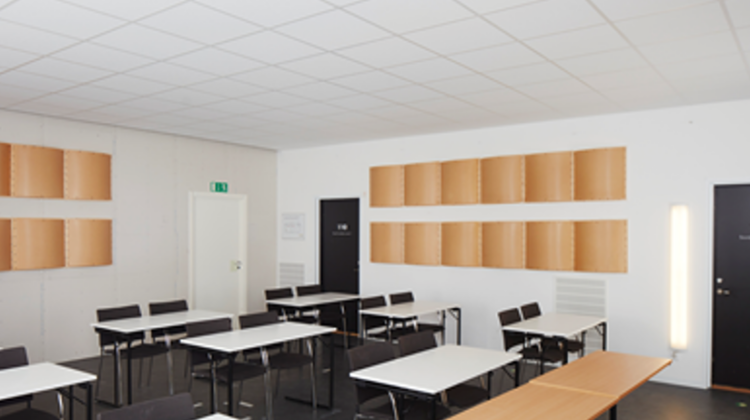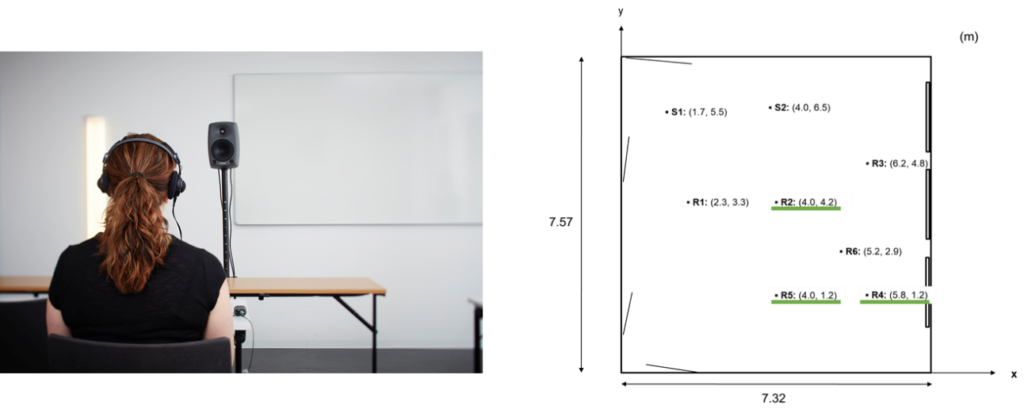
The Subjective Experience Depending on Type of Acoustic Treatment
Recently, PHD student Emma Arvidsson, published an article regarding different acoustic treatments in ordinary rooms and how they are perceived. The article concerns how people subjectively experience different acoustic environments and furthermore, if the experience was different depending on where in the room they were sitting.
The study
In this study five different configurations of acoustic treatments were mounted in a mock-up of a classroom. The different type of acoustic treatments are absorbers and diffusers placed in the ceiling and on the walls. The room acoustic parameters reverberations time (T20), speech clarity (C50) and sound strength (G) were measured.

The design of the study
Speech was emitted from a loudspeaker, Genelec 8030 B, which were placed in a position where a teacher typically would stand. Acoustic center was 1.55 m. The speech was recorded with binaural headphones with calibrated microphones (BHS II, HEAD acoustics) in three different positions in the room. One position just in front of the speaker position, one on the same line but further away from speaker position and one in the corner.

The participants
Twentynine persons performed the listening test. The test was made in another, neutral room. None of the participants knew anything about the different treatments or that they were listening to sounds from different positions. Binaural headphones (BHS II 3322 HEAD Acoustics) with adapter (B2U 3323 HEAD Acoustics) were used for recording and playback equalization.
A pairwise comparison manner was applied. The comparisons were made between different positions for one room configuration as well as between the room configurations. The participants were asked to judge whether they found two different speeches to sound the same or different.

Evaluation
The evaluation of internal difference in a room was made for conf 1-3. Differences in perceived sound between the position close to speaker (R2) and further away (R2/R5 and R2/R4) was clearly observed. Comparing the positions in the rear part of the room (R4 and R5) was the configuration with diffusers on the walls (conf 3) the solution for which people most often experience the sounds to be the same. This can be interpreted as this configuration gives most uniformed acoustic experience.

Comparing different configurations showed that horizontally and vertically oriented diffusers was experienced to be the same by most of the participants. Concerning configuration with ceiling diffusers was it found that people could hear a difference in the rear part of the room, compared to when only absorbent tiles were mounted in the ceiling.

Concerning the relation to the room acoustic parameters was it found in this study that C50 was the parameter that was best related to the subjective experience of the difference in the speeches. About 2 dB difference was needed for people to experience a difference.
To summarize
People experienced most uniformed acoustics in a room when diffusers were placed on the walls. Replacing absorbing ceiling tiles with diffusing tiles gave a difference in the acoustic experience for positions in the rear part of the room. The difference in acoustic experience was best related to C50.
In the work going forward will attributes and judgement of how good people find these different configurations be investigated.
_____________________________________________________________
For more details just reach out to us or you can find the full article on:
Furthermore, a previous study focusing on the room acoustic parameters related to these acoustic treatments can be found in previous post here on Acoustic Bulletin:
or as a full article on:

